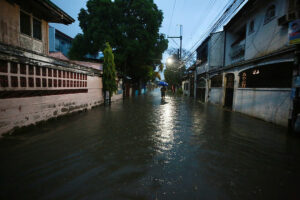By Edg Adrian A. Eva
WHEN the Southwest Monsoon (Habagat) was enhanced by Typhoon Carina, it devastated large parts of Luzon. Many Filipinos were haunted by memories of Ondoy, a typhoon that caused record-breaking levels of flooding in Metro Manila.
Rhea Perez, a mother of three and a resident of Barangay Gulod, Novaliches, Quezon City, is no stranger to flooding as she grew up near the Tullahan River.
“With Ondoy before and then this, it’s really been traumatic for us,” Mrs. Perez said in Filipino during an interview.
“We were already awake at 4 a.m. putting aside our belongings,” she said.
“We got scared that the flood rose quickly. By the time we were rescued, the water had already reached the second floor,” Ms. Perez said.
As she returned to their home after the flooding, she remembered their experience with Typhoon Ondoy, as most of their belongings have been washed away by the flood.
“We were back to zero again,” she said.
LOOKING BACK AT TYPHOON ONDOYThe rainfall and flooding caused by Typhoon Ondoy in September 2009 have become a benchmark for subsequent floods in Metro Manila, according to Philippine Atmospheric, Geophysical and Astronomical Services Administration (PAGASA).
The storm inundated 80% of the capital, affecting Pasig, Quezon City, Manila, Caloocan, Muntinlupa, and Marikina, as well as nearby provinces.
The Marikina River’s water level rose to 23 meters above sea level, exceeding the 16-meter threshold that prompts evacuation of nearby residents.
Floodwaters as high as 20 feet (6 meters) were observed in areas of Marikina, Pasig, and Quezon City.
Typhoon Ondoy affected 993,227 families and resulted in 464 deaths, 529 injuries, and 37 people remaining missing, according to the National Disaster Risk Reduction and Management Council (NDRRMC).
An estimated P11 billion in damages to infrastructure and agriculture was caused by the typhoon.
CHALLENGES• Urban congestion
The subsequent flooding in Metro Manila is attributed to the capital’s urban congestion, according to Armando Alli, an architectural consultant and environmental planner.
“The area on which the National Capital Region (NCR) sits is a massive 640.0 square kilometer floodplain. It is not actually ideal for very high-density human settlements,” Mr. Alli said.
Another issue pointed out by Mr. Alli is that urban congestion manifestations, such as structures near waterways and waste management problems, have further exacerbated the capital’s problem of flooding.
• Plastic waste
About 356,371 metric tons of “mismanaged plastic wastes” are dumped into 466 rivers across the country each year, according to a peer-reviewed study published in the Science Advances journal.
Notably, Pasig River ranks as the world’s top contributor, accounting for 6.43% of global plastic pollution.
“Require businesses to shift away from single-use plastics by adopting reuse and refill systems, and utilizing reusable materials,” Marian Ledesma, Zero Waste Campaigner of Green Peace said in a written interview.
• Water from the mountains
According to urban planner Felino A. Palafox, Jr., the region’s waterways can no longer handle the volume of rainwater flowing from nearby mountains.
“More than 4,600 cubic meters per second flowed down from the denuded mountains but the capacity of Pasig River is 600 cubic meters during Ondoy,” Mr. Palafox said.
The remaining 4,000 cubic meters of excess flood water flowed into residential areas in Metro Manila, he said.
• PHL in typhoon belt
According to PAGASA, the Philippines’ ongoing struggle with flooding is largely attributed to its geographical location within the “typhoon belt” found in the Western Pacific.
“The geographical location of the Philippines really makes it more vulnerable,” PAGASA Hydrologist Rosalie C. Pagulayan said in Filipino.
On average, up to 20 tropical cyclones enter the Philippine Area of Responsibility each year, with about 8 or 9 of these making landfall in the country.
• Climate Change
PAGASA warns that extreme meteorological events may become more frequent due to climate change.
“That’s what our climatologists always say — we could experience extreme climatic events,” Ms. Pagulayan said.
The Philippines is in the forefront of disaster risks among 193 countries from the effects of climate change, according to World Risk Index.
This study indicates that the impact of climate change is also worsening due to the lack of societal capacities and resources in the Philippines.
FLOOD CONTROL PROJECTSA pressing concern for communities constantly plagued by these floods is how much longer they need to endure this.
DPWH Secretary Manuel Bonoan admitted that there is no single nationwide master plan for flood control in Metro Manila, but more than 5,000 completed flood projects are intended to provide immediate relief and protection for low-lying areas.
“Our decentralized strategy allows us to customize solutions for each major river basin, considering their unique geographical, hydrological, and environmental conditions,” Mr. Bonoan said.
One significant flood control project is the ongoing P351-billion plan for flood management in Greater Metro Manila.
According to the World Bank, the notable measures include construction of the Upper Marikina River Catchment Area, construction and modernization of pumping stations along critical waterways and improved solid waste management for the drainage systems.
The project completion is at 30% and is facing delays due to various factors, including environmental, social, and other issues, Mr. Bonoan said.
Mr. Palafox suggested that a similar concept to the water impounding structure in BGC (Bonifacio Global City) could be applied to some major roads in Metro Manila.
“Let’s say underneath roads like EDSA, you put a big cistern, collect the water before they flow down,” he said.
“We can have a six series of rainwater harvesting in the circumferential roads.”
IS THERE STILL HOPE?Despite the daunting challenges facing the country’s flood management efforts, the NDRRMC remains hopeful, believing that the nation can become flood-resilient — if only we can get our act together.
The government is prioritizing and investing in engineering, science-based, and long-term solutions to effectively address the country’s flooding issues.
Mr. Alli believes that achieving flood resilience within 18 to 25 years is possible, but only if we commit to a concerted effort across multiple administrations.
“It has to be a very well-coordinated and sustained effort using a combination of natural and artificial solution that must put politics in the backburner,” Mr. Alli said.






